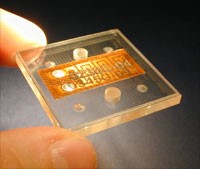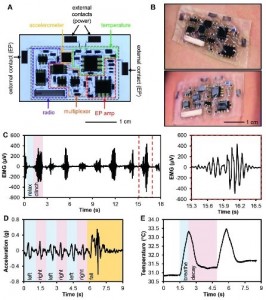Wearable Monitors that tests for Human Wellness
by Dante X. Harris
Microfluidics, similar to nanotechnology, is a new science technology that designs and creates devices by the usage of tiny volumes of fluid. The measurements used in microfluidics are nanoliters (nl), or pictoliters (pl). But microfluidics is a field study that includes multiple disciplines. These disciplines include chemistry, physics, biochemistry, nanotechnology, and engineering. The advances in microelectronics have allowed scientist to discover a noninvasive, different, efficient, and beneficial way to test human’s health and wellness without the necessities of going to a hospital or a clinic.
Researchers at Frederick Seitz Materials Research Laboratory in the University of Illinois (in collaboration with other scientists) have created a high-quality, small, stretchable, durable, and wearable monitor that is mounted onto the skin. This monitor contains multiple sensors, circuits, circuit boards, conductors, radios, and power supply systems that allow for signal collection or transmission.
The wearable monitor also has a skin-like texture that is comfortable and can softly be placed onto the skin. The monitor has a built in wireless mode that allows for multifunctional operations for physiological monitoring. Physiological monitoring includes: blood pressure, heart rate, reflexes, and respiration.
The materials used to create the monitor are small microchips containing data and information on the particular patient. Usually the monitor would be placed on the forearm of the patient. In order to continuously test for physiological monitoring on the body requires optical, fluidic, and electrical interfaces/ processes. Optical interfaces, in a microchip, is a form of communicational link where one optical signal, or receiver, is passed from one piece of equipment to another without using any electrical signals. Next, a fluidic interface is the controlling material of the monitors operations. Lastly, electrical interfaces refers to the connectivity and electrical outputs for the monitor.
Every piece of material inside the monitor is essential and necessary for data collection. The monitors materials allows understanding of a whole range of applications or studies, ranging from training in sports to tracking sleep apnea, cognitive state and awareness. Scientist at the Center for Mechanics and Materials in Tsinghua University, Beijing, have run many tests and studies on the monitor to ensure the success rate of the device.
At this moment the wearable monitors are still going through many trial and tests and will not be available to the public. Many scientists conclude that this wearable monitors for human wellness will be the new generation for out-patient care. Over the next decades, there are possibilities that the monitors will be commonly used throughout the world.
If you are interested to know more about the subject, here is the original article:
Xu, Sheng, et al. Soft Microfluidic Assemblies of Sensor, Circuits, and Radios for the Skin. Science Magazine. 2014 American Association for the Advancement of Science. Vol. 344 no. 6179 pp. 70-74 DOI: 10.1126/science.1250169. 4 April 2014. Web. 22 April 2014. Retrieved from: http://www.sciencemag.org/content/344/6179/70.full
For further reading:
http://www.sciencemag.org/content/300/5621/955.full?sid=a9dedc42-b0b6-4f37-af9d-80588d8b5b45
http://www.sciencemag.org/content/337/6102/1640.full?sid=907f4512-e9a4-4f69-ad14-be5200a46b6a
http://www.sciencemag.org/content/333/6044/838.full?sid=907f4512-e9a4-4f69-ad14-be5200a46b6a
http://www.ncbi.nlm.nih.gov/pubmed/19963864
http://www.ncbi.nlm.nih.gov/pubmed/17947174
http://www.ncbi.nlm.nih.gov/pubmed/17869159

